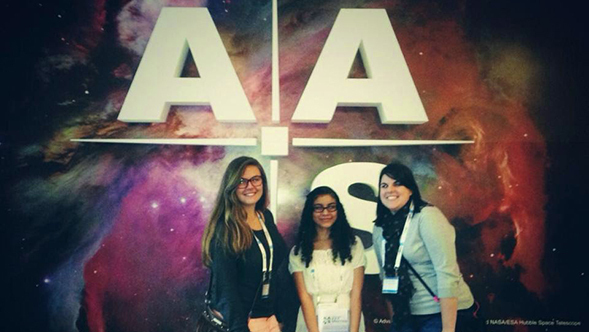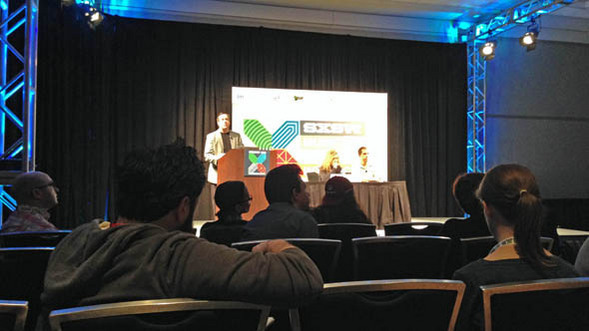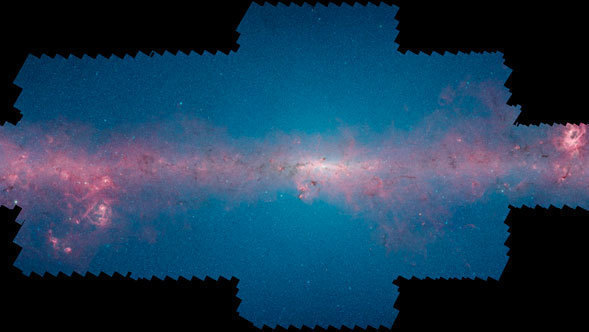
By Danielle Miller | June 30th, 2014
If you've been following my blog, you know I was lucky enough to be part of the NASA/IPAC Teacher Archive Research Program, or NITARP. It was an amazing year and the program wrapped up with a trip to the American Astronomical Society meeting with two of my students in January.
The AAS meeting was a ton of fun this year, just like last year. It was way colder, but a ton of fun. I’m glad I had students with me, but it was definitely more difficult to plan sessions and posters to see with students who didn’t have a huge astronomy background. They were great at the science we did and I could see light bulbs any time any one mentioned light curves or Kepler… but some of it went right over our heads (myself included).
Our time at AAS 223 started with a trip to the opening reception. It put me and my students a bit out of our comfort zone. I’m not super good at mingling and high schoolers are usually super uncomfortable with just walking up to adults they don’t know, but we managed alright. Probably my favorite moment was when one of my students walked up to a professor from Vassar (where she’ll be going in the fall) and introduced herself. She’s usually pretty quiet, so I was really excited that she at least said hi.
Our second day was very very busy, especially because our poster was up! We started with the Plenary Session with Robert Williams from the Space Telescope Science Institute about the Hubble Deep Field. If you don’t know about the Hubble Deep Field, you should! The photo was taken in 1995 and at the time was not very popular because it was pretty risky. The results however, are amazing, and the photo contains more than 3,000 objects, most of which are galaxies. Why is it so important? As Robert Williams said during the session: "if you want to understand the present, look into the past." If you’d like to learn more about the Hubble Deep Field, check out this really cool NASA resource: http://hubblesite.org/hubble_discoveries/hubble_deep_field/
We also checked out the “Planet Hunters” session, which was a really cool view of exoplanet astronomy and citizen science with Dr. Meg Schwamb. If you’d like to look for exoplanets by studying stellar variability or as she said, “flicker, jitter, and crackle” be sure to check out http://www.planethunters.org/. Citizen science really is great. During the session, she said that there have been 20 million classifications by 280,000 people since 2010. Also, the Planet Hunters ‘Talk’ feature is like facebook for light curves. Conversation and collaboration is huge in citizen science.
Next, we visited the Kepler town hall, which the students were very excited about because we used Kepler data to do our research. They had an updated graph of exoplanets found with Kepler (which has now been updated again and you can see here: http://www.nasa.gov/content/sizes-of-known-exoplanets/#.U7HXj5RdWSo). The K2 mission was the highlight of the town hall, because Kepler’s reaction wheels went a little funky, the telescope couldn’t really keep doing what it was doing, but scientists were able to figure out another way to do the science, and now, it is! (I still think if NASA could have figured out a way to get Mike Massimino up there, he somehow would have been able to fix it. I’ve seen that Hubble movie at Kennedy Space Center a bunch of times.)
After a full first day, our even started with us talking at our poster! All of our other team members took the morning shift, but we had the last one… and it was AWESOME. So many people stopped by to talk with us and the students had a great time meeting people, answering questions and talking all about our research. Everyone seemed pretty impressed, and a few people even asked us if we were going to publish our results! Once the time was up my students and I thought that we wished we had more time. Talking to everyone was way more fun than we expected (we were pretty nervous at the beginning!). It was definitely a little weird to feel like we just squeezed a whole year of work and research and red giants into one poster and one day of talking to people...but I guess that's science, right? Just in case you still haven't seen our poster, you can check it out here! http://nitarp.ipac.caltech.edu/system/media_files/binaries/130/original/miller14.pdf
Then we headed to a NITARP meeting/discussion session/photo shoot with everyone in the program and right to something I was pretty excited about, “Tales from the Twitterverse and other Media Excursions” with Neil deGrasse Tyson. If you were on twitter and following along that night, you know that Dr. Tyson did not impress everyone, but my students and I thought it was great. I thought he followed along pretty closely with the description in the program and my takeaway was that social media can be very powerful, if used the right way. (My other takeaway was that sometimes if you make one person mad, lots of people on twitter will join in on the mad – even if they’re not there.) Dr. Tyson shared a great story with us about how learned his lesson about communication after an interview with a local news station. He said he gave them a great interview, but because he didn’t talk in sound bites, they only took one part, something about him saying stars wobble – while doing a little dance. The dance was all they showed. From then on, he decided to only speak in sound bites, which translates very well to twitter’s 140 character thing. He also focused on using humor to communicate science, which is where I think some people were offended. He did use some colorful language, but he warned us about it at the beginning, and I didn’t feel like it was stuff my students couldn’t handle, they hear things much worse in the hallways at school, for sure. According to this website which was shared on twitter that night, Neil Tyson has way more followers on twitter than all the other astronomy folks combined. http://lucretius21c.wordpress.com/astronomers-on-twitter/
My final tweet that night was this:
@d_l_miller: take away from @neiltyson at #aas223? Use twitter (and other social media) for good. Make science accessible. The people will make it cool.
Our third day started off with running into Neil deGrasse Tyson on the escalator (no, really!) and a few more sessions. We started with “Observing Asteroids for Fun and (Astronomical) Profit” with Linda French, which was a great Amateur talk that both my students and I found interesting and easy to understand. We learned about how asteroids can reveal lots of things about the early solar system and that, according to Linda French “light can move mountains in space,” it’s called the Yarkovsky effect…and it’s really cool. Even though our research was with Kepler, we learned about Spitzer during our time at Caltech in the summer, so we also went to the “Spitzer Space Telescope: The Next Ten Years” session. The scientists estimate that even though it’s been going strong, Spitzer can continue to make observations until 2018 or so. If you haven’t been keeping up with Spitzer news, you really should! Cold brown dwarfs, exoplanet atmospheres and interiors, young stars, supernovae, galaxies, clusters… it’s awesome! You can learn more at: http://www.spitzer.caltech.edu/ One thing I noticed during that session though, was that each of the presenters- even though doing very different - all said something along the lines of “before Spitzer, we couldn’t do this.” Isn’t science great?
Next, we went to the NASA Education and Public Outreach Event with the director of NASA’s Astrophysics Division, Paul Hertz. Because the room was mostly full of local students, it wasn’t super high level science, but he did make sure to communicate to the students that STEM is important, that no one at NASA works alone- collaboration is key, and that science is always changing. We then walked around the exhibit hall for the education presentations, and stopped at a few really cool booths. We saw a robotic model of the JWST, talked to the Chandra x-ray folks, and learned a bunch from the William Patterson University Astronomy club. The NASA town hall we went to next was pretty enlightening…the James Webb telescope is a really big deal, in case you didn’t know. At the end, someone in the audience asked about education and public outreach (if you’ve been following along you know is in an…interesting…place right now) and the answer was a very quick “talk to congress.” So, people, talk to congress! Our brains were pretty full by that point, so we decided to take a quick ride on a boat on the frozen Potomac. Later in the evening, we attended a star party in less than favorable single-digit weather for us ladies from Florida. Luckily, there was hot chocolate, and a few trips to just inside the convention center doors so we could sit directly on top of the heaters. We were able to see Jupiter with its moons and our moon up close, plus we took some really cool photos with my just my iPhone held up to the eyepiece of the telescope!
On the next day, we managed to get into Washington, DC. My teacher self would have felt pretty bad about bringing 2 students who had never been before to right outside the nation’s capital without at least running through. So we did a whirlwind few hour trip to the Air and Space Museum (which had a really cool Spirit and Opportunity exhibit), the Natural History Museum, outside the fence of the White House, past the Washington Monument, into the American History museum and then back to the hotel. Yes, our feet hurt. Yes, it was very cold - in the teens, I think. But it was also very fun and full of learning new things for all of us.
The last day there were lots of education posters up – lots of cool resources – and we went to a few talks on stellar evolution, but by then my students and I were pretty tired and overwhelmed by everything. Our trip back went well and it was time to dive right back in to teaching and my team’s robotics league championship the next day. The girls did a lot of work while I was away, so we made it states for the second year in a row.
I procrastinated on this blog for awhile… and as I sit here finally finishing it, I know why. I just don’t want NITARP to be over. And even though NITARP may be over for me, it could be just starting for you! The application for 2015 is available here: http://nitarp.ipac.caltech.edu/news_item/408 and is due on September 22nd. Go on, apply…for SCIENCE!
Read this blog and see more pictures on Danielle's Blogspot.
 NASA & Spitzer @ SXSW
NASA & Spitzer @ SXSW
 Become a Photojournalist of the Milky Way!
Become a Photojournalist of the Milky Way!



